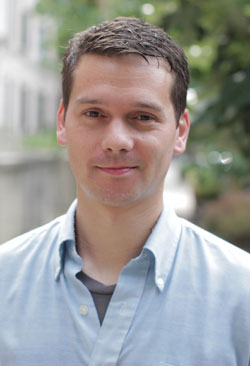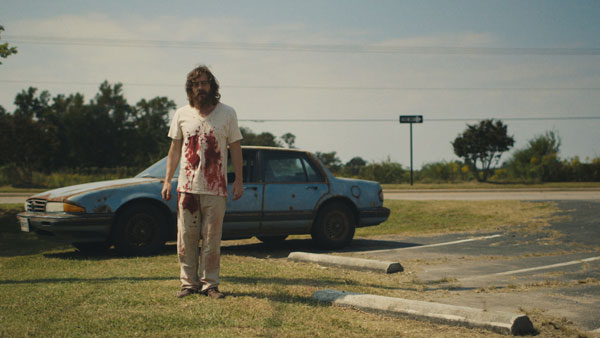A classic American revenge story and a recent hit at Cannes, Blue Ruin follows a mysterious outsider whose quiet life is turned upside down when he returns to his childhood home to carry out an act of vengeance. Proving himself an amateur assassin, he winds up in a brutal fight to protect his estranged family. Writer/director/D.P. Jeremy Saulnier, lauded for his work as a cinematographer on provocative recent indies like Putty Hill and Septien, unspools his second directorial effort with stark economy and unnerving potency, crafting a guttural neo-noir that packs a mean, lean punch.
Update April 2014:
Blue Ruin premieres in theaters, on demand and on iTunes on April 25!
Note: This interview originally ran as part of the HIFF 2013 interview series.
Please describe your film in your own words.
Jeremy Saulnier: Blue Ruin is a procedural account of an ill-fated revenge mission and its surprising, tragic and sometimes hilarious aftermath. The story follows Dwight (Macon Blair), a kindhearted beach bum turned assassin. Compelled by love, fear and a distorted sense of justice, he thrusts himself into a violent situation and comes face to face with his own ineptitude. He is a man not cut out for revenge killing, and as we watch Dwight flail in desperation and fight to right his wrongs, we might just fall in love with him.
What inspired you to tell this particular story?
JS: The story was born out of necessity but soon evolved into an incredibly personal work of art. Initially, there were two simple objectives: showcase my ability as a director and showcase Macon’s ability as an actor. We needed jobs.
The Beach Bum character was something Macon and I had discussed for years, but the narrative around him shifted from a dark comedy to a revenge scenario for practical reasons (the comedic premise I had envisioned soon popped up in the trades as the plot of a Hollywood film, and so it was scrapped). I told Macon, “Fuck it, we’re doing a revenge movie.” Not an entirely original idea, but we’d set ourselves apart by doing everything wrong. By casting the ‘wrong’ lead (Macon—who is by no means your typical chiseled, ex-military badass), and by exploring what might happen if the usual American revenge scenario continued past its standard deadly conclusion. What if our guy totally fucks up? What if we run out of testosterone?
All the while, I had been attending U.S. film festivals (as a cinematographer) and saw a void in the marketplace. There were very few independent genre films that really put themselves on the line. There were lots of jokey, self-referential material, and plenty of loud, ‘found footage’ massacres, but there seemed a lack of traditional, quiet craft.
Making Blue Ruin was an attempt to fill that void and to strike a delicate balance between emotional depth and cheap thrills, catering to both art-house cinephiles and diehard genre fans.
But, as I wrote the script, the ‘marketplace’ mentality and economic practicalities quickly gave way to a total immersion in story and character. My cynical exploitation film became a deeply personal exploration of parental mortality, family dynamics, the end of patriarchy, etc. There are even convoluted layers of religious and secular symbolism for those who want to dig deep. The experience was so emotional I’m embarrassed to discuss it. As I became fully invested in the story, and with Macon in the character of Dwight, Blue Ruin became much more than either of us anticipated.
As the writer/director/cinematographer on Blue Ruin, how did you manage to juggle wearing so many hats during the production?
JS: I’ve never been able to separate the different jobs on a set. I learned my craft in grade school as part of a suburban filmmaking collective. We just ran around and made stuff, serving whatever role was needed at the time: director, cameraman, stunt driver, pyrotechnician, etc. A creative shit-storm.
Wearing so many hats on Blue Ruin was nothing new, but the stakes were certainly higher. So I made sure to communicate my aesthetic and technical intentions as early as the script phase. My approach to filmmaking has always been visual. Even when writing, I experience the film as if I’m watching it, and then describe on paper what I see. On set, as a director/cinematographer, this ‘collaboration with myself’ was rather seamless during the film’s more crafted, cinematic sequences. But when it came time to shoot our three intense and emotional dialogue-driven scenes, this ‘collaboration’ faltered. Distracted by technical issues when operating the camera, I’d forget my performance notes on a take by the time it was over. Good thing I had great actors to lean on!
Who are some of your filmmaking idols? Did any particular thrillers influence Blue Ruin?
JS: While I admire the careers of many directors, my cinematic reverence is for specific films—too many brilliant artists are hit or miss (Friedkin, Carpenter, etc.). I’d say the biggest influences for Blue Ruin would be the Coens’ No Country for Old Men, Wim Wenders’ Paris, Texas, and Michael Mann’s Thief.
What do you want audiences to take away from your film?
JS: I risked everything I had on this film and I’m grateful for how well its been received. I sincerely hope audiences walk away from Blue Ruin in a stupor, impacted by the mess of raw emotion, cinematic beauty, brutal violence and dark humor.
But I’ll be happy if they just give me 92 minutes of their time and turn off their cell phones.
Do you have one piece of advice for aspiring filmmakers?
JS: Yes: THE INDUSTRY OWES YOU NOTHING. If you want to make movies, you must understand that you have to earn your way in. Prove yourself. Fail. Be patient. Have a parallel career or learn a technical trade (for me, it was camera work). Meet and work alongside those who make films. Keep making movies. Excel at your day job. Don’t be a jerk. You might make an amazing film that nobody will see or a mediocre one that will get into competition at Sundance, but breaking through is not entirely up to you. There are producers, programmers and tastemakers that might seem like sentries at the gate, but they can become your greatest advocates if you prove yourself. Just keep in the game. A cocktail party introduction or someone calling in sick on a film set can change your life. Be there when that happens.
What are you most looking forward to at the 2013 Hamptons International Film Festival?
JS: I live in Brooklyn, so the Hamptons International Film Festival is close to home. It’s the first time I’ll be able to share Blue Ruin with an audience without leaving my wife and three daughters behind. The whole clan is coming!
Blue Ruin screened in the Golden Starfish Narrative competition at HIFF 2013. Facebook | Twitter | Website
See Blue Ruin in theaters, on demand and on iTunes starting April 25!
 Born and raised in Alexandria, Virginia, Jeremy Saulnier now works as a director and cinematographer in Brooklyn, NY. He studied at NYU’s Tisch School of the Arts and braves the corporate video world to finance his independent film habit. He directed and photographed the award winning short Crabwalk, and the cult horror-comedy Murder Party. Notable cinematography credits include Septien (2010), and his collaborations with director Matthew Porterfield—Hamilton (2007), Putty Hill (2010) and I Used to Be Darker (2013). Blue Ruin premiered in the Directors’ Fortnight section at Cannes, where it was acquired by RADiUS TWC for North American distribution.
Born and raised in Alexandria, Virginia, Jeremy Saulnier now works as a director and cinematographer in Brooklyn, NY. He studied at NYU’s Tisch School of the Arts and braves the corporate video world to finance his independent film habit. He directed and photographed the award winning short Crabwalk, and the cult horror-comedy Murder Party. Notable cinematography credits include Septien (2010), and his collaborations with director Matthew Porterfield—Hamilton (2007), Putty Hill (2010) and I Used to Be Darker (2013). Blue Ruin premiered in the Directors’ Fortnight section at Cannes, where it was acquired by RADiUS TWC for North American distribution.







